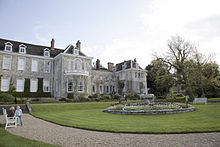

Thomas Gage, 1st Viscount Gage (bef. 1702 – 21 December 1754) was a British peer and Member of Parliament.[1]
He was born the eldest son of Joseph Gage of Sherborne Castle and Elizabeth Penruddock, the daughter and heiress of Sir George Penruddock. He succeeded his father-in-law to High Meadow in 1714.
He married Benedicta Maria Theresa Hall (daughter and heiress of Henry Benedict Hall of High Meadow, Gloucestershire and Frances Fortescue) in 1717. Their first son, William Hall Gage, 2nd Viscount Gage, was born in 1718. Gage also had a daughter, Theresa, and a second son Thomas Gage who would go on to fame as Commander-in-Chief of the British Army in British America at the beginning of the American War of Independence.
On 14 September 1720, King George I created him Baron Gage of Castlebar in the county of Mayo, and Viscount Gage of Castle Island in the county of Kerry of the Kingdom of Ireland.
From 1721 to 1754 Gage served in Parliament representing Tewkesbury. As a Member of Parliament he exposed the fraudulent sale of the Derwentwater estates on 31 March 1732, and was subsequently rewarded with £2,000 for this under the Greenwich Hospital Act 1735.[2] In 1738, Gage was appointed as Governor of Barbados, but the appointment was never approved, probably because he lacked sufficient political connections.[3]
On 23 April 1744, his cousin, Sir William Gage, 7th Baronet, died without children, and Gage inherited the baronetcy and the family estate of Firle Place. Sir William's late father was Gage's uncle - Sir John Gage, 4th Baronet, Sheriff of Sussex. The main line of the family, up to the 7th Baronet, had been Roman Catholic recusants who had purchased their baronetcy from King James I. However, Gage had converted to the Church of England in 1715, perhaps to enable him to sit in parliament.[4] He later quietly resumed practising Roman Catholicism, although his children were raised in the Church of England.
Gage's wife died on 25 July 1749, and on 26 December 1750 he married secondly Jane Godfrey, a Gloucestershire heiress.[5] He had extensive remodelling work done on Firle Place and between 1743 and 1753 was involved in a number of land rights disputes regarding windfall trees, soil rights, and manorial waste. Gage also spent considerable time collecting paintings which are still housed in the Long Gallery of Firle Place today. From 1747 to 1751 he served as Steward of the Household of Frederick, Prince of Wales.
Gage died on 21 December 1754 and was buried at Firle. He was succeeded by his son William Hall Gage.
See also
Notes
- ^ "GAGE, Thomas (c.1695-1754), of High Meadow, Glos". History of Parliament Trust. Retrieved 27 October 2018.
- ^ Statutes at Large (1758 edition) V, 8 Geo. II, c.29.
- ^ Alden (1948), p. 6
- ^ Alden (1948), pp. 5,8
- ^ Alden (1948), p. 8
References
((reflist))
- Alden, John R (1948). General Gage in America. Baton Rouge, LA: Louisiana State University Press. ISBN 978-0-8371-2264-9. OCLC 181362.